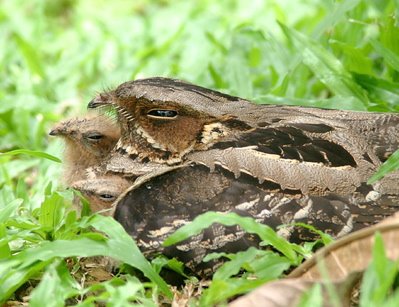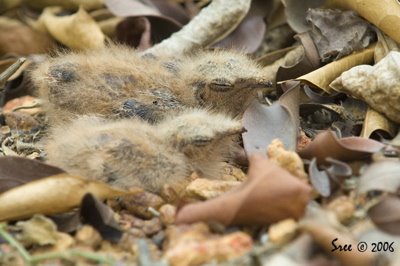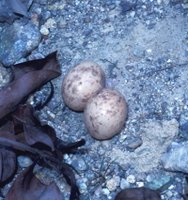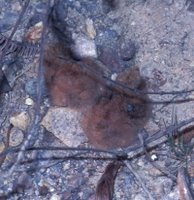The Large-tailed Nightjar (Caprimulgus macrurus) is a nocturnal bird easily detected in the night when it responds to the beam of your torchlight with a pair of red eyes. In the day you come across it walking through scrubland when the bird suddenly scrambles off noisily. You would have probably disturbed it nesting on the ground. This cryptic bird is not easily detected otherwise. It nests on the open ground, using a small piece of ground that is scraped clean of debris.
Sreedharan Gopalsamy was at Air Keroh, Malaysia with his family in May 2006 when he encountered the antics of this bird. “I was there with my wife, Mala, and son, Varun, looking for and photographing birds. We eventually went to the area where we knew that the nightjar was nesting and walked around slowly and carefully, scanning the ground. When all of a sudden I felt and saw something brush my feet. It was the parent nightjar. It then moved about half a meter away and feigned an injured wing. After about 5-10 seconds of this, it moved about 5 meters away and repeated this behaviour and yet again about 10 meters away. Each time trying to get me to follow it. It subsequently flew to a long branch before heading into the undergrowth. Throughout this sequence my son, who was beside me, and I were rooted to our spot. My wife was a few meters behind.
“It turned out that we were about 10 meters away from the nest (rather than stepping on the nest as Varun initially feared). I took my few shots and we moved away so that the mama could come back and look after her chicks. It was unusual for me in that I was not aware that nightjars exhibited this behaviour and that the parent would be so bold as to actually brush my feet.”
Comment by YC Wee: I had the same experience some 20 years ago at Kent Ridge. As I was walking through the sparse undergrowth bordering the then Department of Botany, an adult Large-tailed Nightjar scrambled away and laid on the ground some distance away freigning a broken wing. As I followed it, it scrambled further away and so on. Returning to the original spot, I noticed a pair of eggs lying on a cleared piece of ground. A few days layer I when I was near the nest the incubating bird flew off noisily, leaving a pair of fluffy chicks. I returned the next morning taking care not to disturb the bird and managed to take a picture of the adult bird sitting on its crude nest.
Input by Sreedharan Gopalsamy; images by Tang Hung Bun (top), Sreedharan (middle) and YC (bottom, small).













3 Responses
The first shot shows a different side of a usually fierce looking bird 🙂
-overdodo
Where would be a good place to watch nightjars?